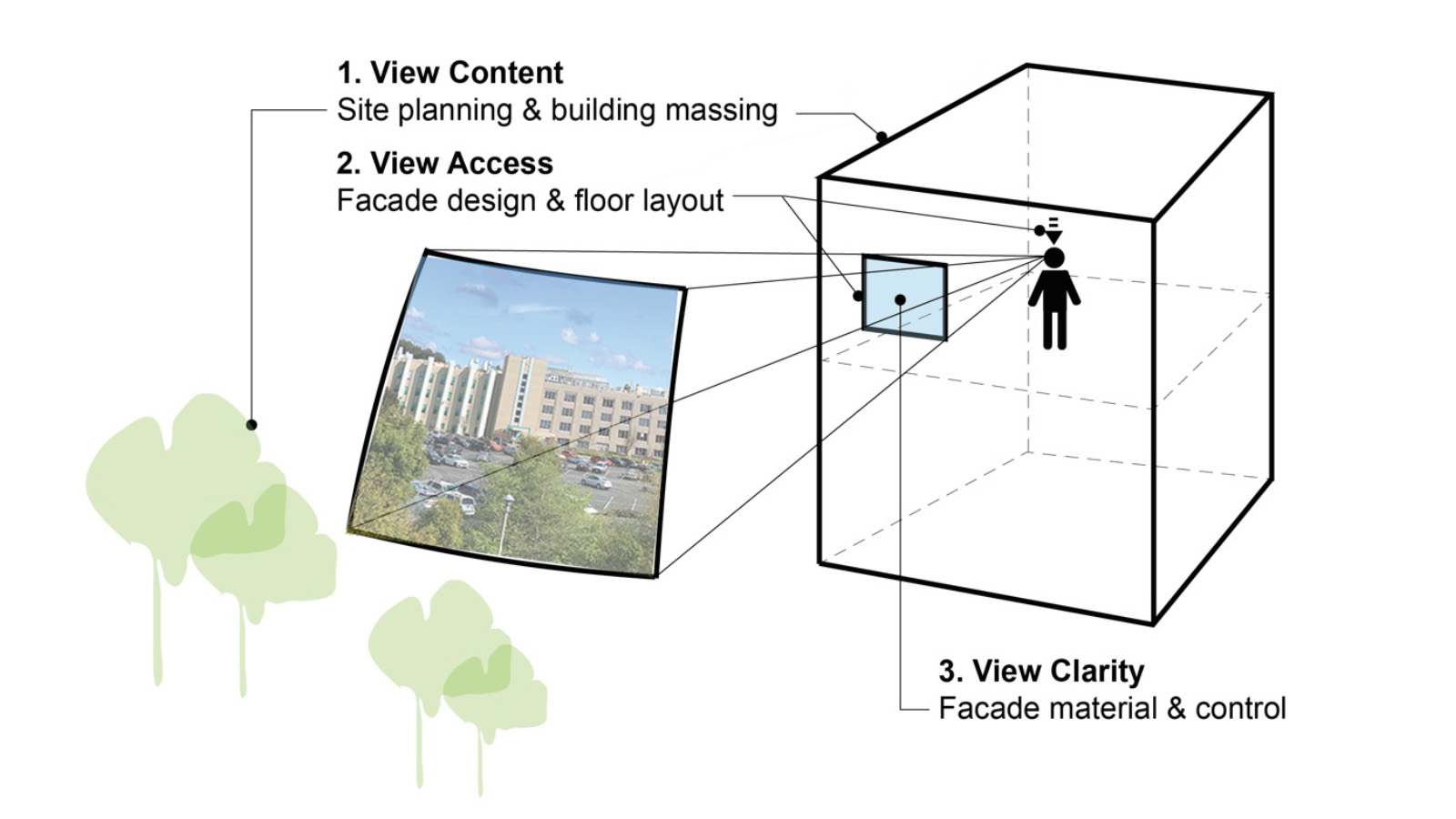Multi-project research to provide structure for design and research related to window views.
Status: Current
Funding Sources: CBE Industry Consortium View Inc.
Project Objective
An overarching goal of this work was to create a cohesive framework for evaluating the quality of views from windows. This framework aims to pinpoint key variables that can be used to guide design choices, and to suggest directions for future research.
Significance to Industry
Windows play a crucial role by connecting indoor spaces to the outside world. Since we spend a considerable amount of time indoors, these architectural features are vital for maintaining our link to the environment. Previous research shows that views to the outdoors may affect our physical and mental well-being, contributing positively to various aspects such as health, cognitive function, spatial satisfaction, stress relief, and emotional responses. Although there have been many studies that examine the effects of windows and natural light, a comprehensive design framework for architects and practitioners was lacking.
Research Approach
This work has been advanced through an ongoing multi-year effort led by graduate students and faculty from UC Berkeley and with support of affiliated institutions. Here we outline and link to key studies and a related event, the full citations are listed in the publication section below. Several of these studies were led by Won Hee Ko as part of her PhD studies while at UC Berkeley, including her lab study on window views.
A Window View Quality Assessment Framework
Literature related to window views is widely dispersed across disciplinary fields, leaving a need to coalesce this information into a framework that can be applied into the building design. Based on the literature, in this paper from 2021 the authors present a framework for what constitutes “view quality.” At the basis of our framework, we propose three primary variables: View Content (the assessment of visual features seen in the window view); View Access (the measure of how much of the view can be seen through the window from the occupant’s position); and View Clarity (the assessment of how clear the view content appears in the window view when seen by an occupant).
View Access Index: The Effects of Geometric Variables of Window Views on Occupants’ Satisfaction
This study assessed the effect of geometric variables on view access satisfaction, with 40 participants that rated simulated images in virtual reality headsets. The authors developed an index that predicts view access satisfaction, and found that glazing area, window distance and viewing direction were the primary predictors. the authors recommend a minimum of 25% window to wall ratio, and and a 35 degree horizontal view angle for view access.
Assessing the Impact of Glazing and Window Shade Systems on View Clarity
Various glazing and window shade materials are used to mitigate glare, overheating and privacy issues, and they affect view clarity. This study evaluated the effect of window films, electrochromic (EC) glass, and fabric shades on view clarity, with a lab experiment with 50 participants using visual tests adapted from clinical vision tests (visual acuity, contrast sensitivity, color sensitivity) and images displayed on a computer monitor in a controlled laboratory. The open access paper notes that window films and EC glass tints outperformed fabric shades in visual acuity, contrast sensitivity and view satisfaction with some exceptions. Generally, higher visible light transmittance and lower solar reflectance (darker color) enhance human visual performance. The paper also identifies the primary variables and establishes a predictive framework for assessing view clarity of fenestration.
An additional paper by many of these same authors have characterized view clarity around three key dimensions: (1) the shading solution, (2) the view content, and (3) aspects of the observer. While the authors note that is may be difficult to predict view clarity for all the situations that can occur in a building, their the goal is to share insights that can “help designers consider the many impacts within the context of overall window design.”
Symposium on Research and Design Practice Related to Window Views, October 2021, and Position Statement
We brought together experts from engineering, manufacturing and academia for a full day session on view quality. The key objectives of this symposium were: (1) to enhance global interest and understanding among building designers and managers on the benefits of view, (2) to promote significant research results to the design and research communities, and (3) to help designers to adapt research findings to building designs. Speakers included researchers, designers and other experts who will discuss current research and design practice, followed by Q&A and a discussion of future directions. Speaker bios, presentation slide decks and links to the videos are on the CBE event page. Viewers may also go directly to the YouTube playlist.
This symposium led to the development of this position statement, providing the “initial steps to solidify our understanding of the complex relationships among building design, operation, and human needs regarding window view quality.”
Publications and Reports
Ko, W. H., Kent, M. G., Schiavon, S., Levitt, B., & Betti, G. (2021). A Window View Quality Assessment Framework. LEUKOS, 18(3), 268–293.
Journal paper: https://doi.org/10.1080/15502724.2021.1965889
Open access: https://arxiv.org/pdf/2010.07025- Ko, W.H., S. Schiavon, L. Santos, M.G. Kent, H. Kim, & M. Keshavarzi (2023). View Access Index: The Effects of Geometric Variables of Window Views on Occupants’ Satisfaction. Building and Environment 234, 110132Journal paper: https://doi.org/10.1016/j.buildenv.2023.110132
Open access: https://escholarship.org/uc/item/46p439jv Ko, W.H., Burgess, I., Schiavon, S., Um C.Y., (2024). Assessing the Impact of Glazing and Window Shade Systems on View Clarity. Scientific Reports 14, 18392 https://doi.org/10.1038/s41598-024-69026-x
Kent, M., Ko, W.H., Konstantzos, I., Schiavon, S., MacNaughton, P., Wilkins, A. (2024). The Design of Window Shades and Fenestration for View Clarity. Lighting Research & Technology. doi.org/10.1177/14771535241261270

